Alstria Office REIT-AG Capital Structure: Determinants and Strategy
VerifiedAdded on 2023/06/07
|9
|2042
|304
Report
AI Summary
This report provides an analysis of the capital structure of Alstria Office REIT-AG, a German real estate company, focusing on the factors that influence its capital structure decisions. It examines key determinants such as cash flow position, return on investment, cost of debt and equity, tax rates, floatation costs, associated risks, flexibility, control, regulatory framework, and stock market conditions. The report also discusses the optimal debt-to-equity ratio for Alstria Office REIT-AG, suggesting that a financial sector company like Alstria should rely more on borrowing. Furthermore, it emphasizes the importance of aligning the capital structure with the company's business strategy, highlighting how debt levels should be adjusted based on the predictability of cash flows and overall financial uncertainty. The report concludes by recommending that Alstria Office REIT-AG consider these factors to maintain a sustainable capital structure, balancing debt and equity effectively to support its investment opportunities while managing financial risks.
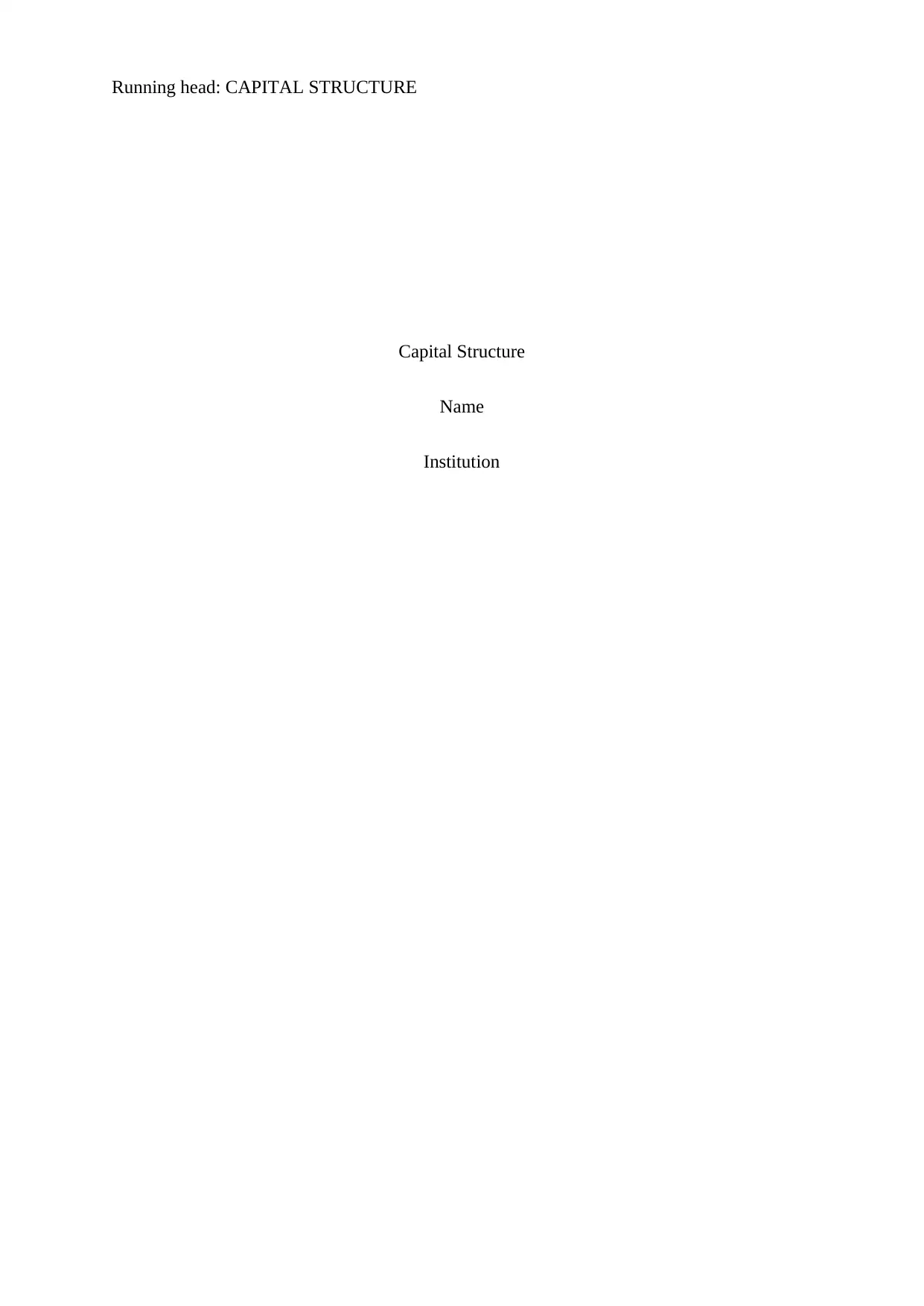
Running head: CAPITAL STRUCTURE
Capital Structure
Name
Institution
Capital Structure
Name
Institution
Paraphrase This Document
Need a fresh take? Get an instant paraphrase of this document with our AI Paraphraser
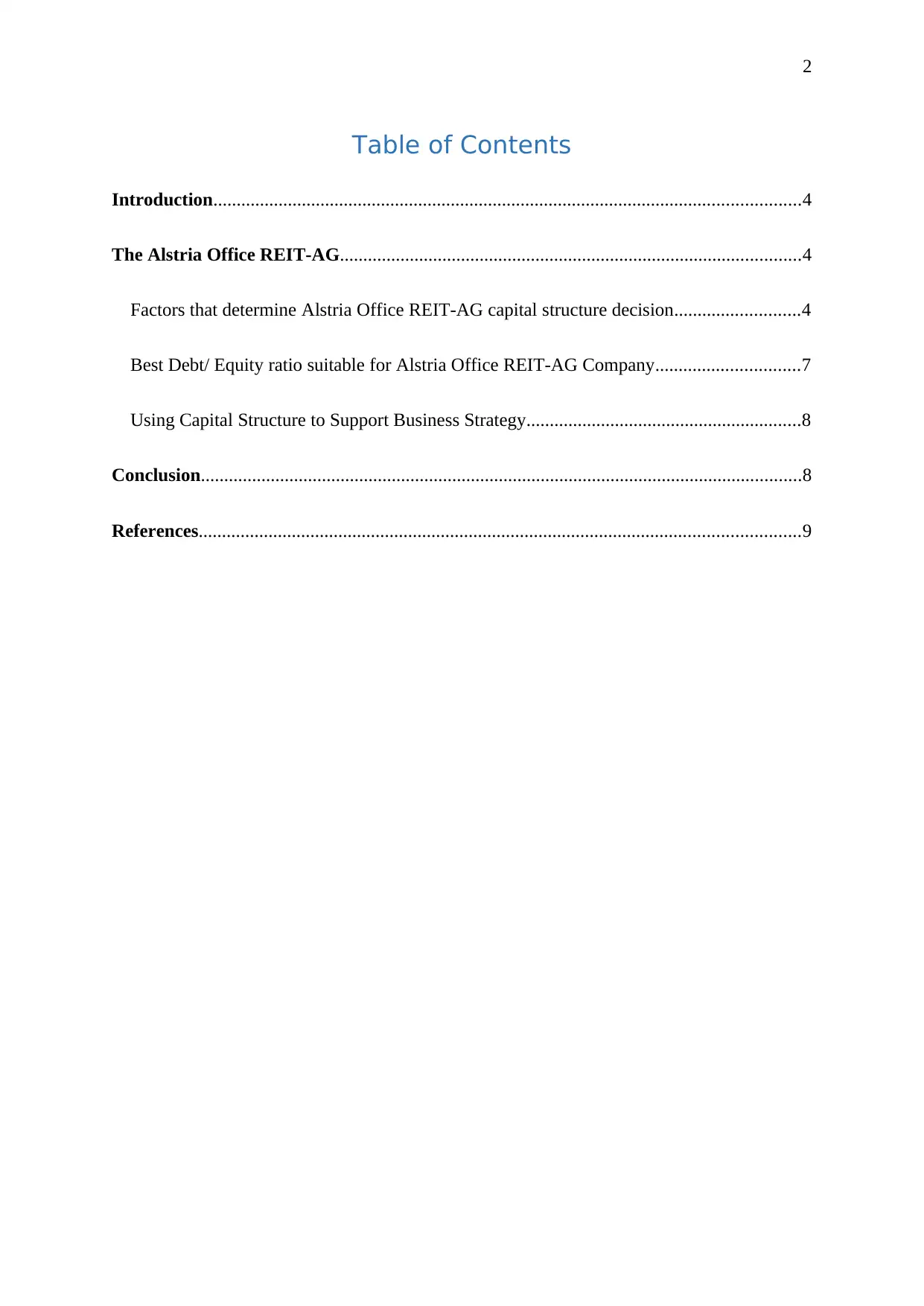
2
Table of Contents
Introduction..............................................................................................................................4
The Alstria Office REIT-AG...................................................................................................4
Factors that determine Alstria Office REIT-AG capital structure decision...........................4
Best Debt/ Equity ratio suitable for Alstria Office REIT-AG Company...............................7
Using Capital Structure to Support Business Strategy...........................................................8
Conclusion.................................................................................................................................8
References.................................................................................................................................9
Table of Contents
Introduction..............................................................................................................................4
The Alstria Office REIT-AG...................................................................................................4
Factors that determine Alstria Office REIT-AG capital structure decision...........................4
Best Debt/ Equity ratio suitable for Alstria Office REIT-AG Company...............................7
Using Capital Structure to Support Business Strategy...........................................................8
Conclusion.................................................................................................................................8
References.................................................................................................................................9
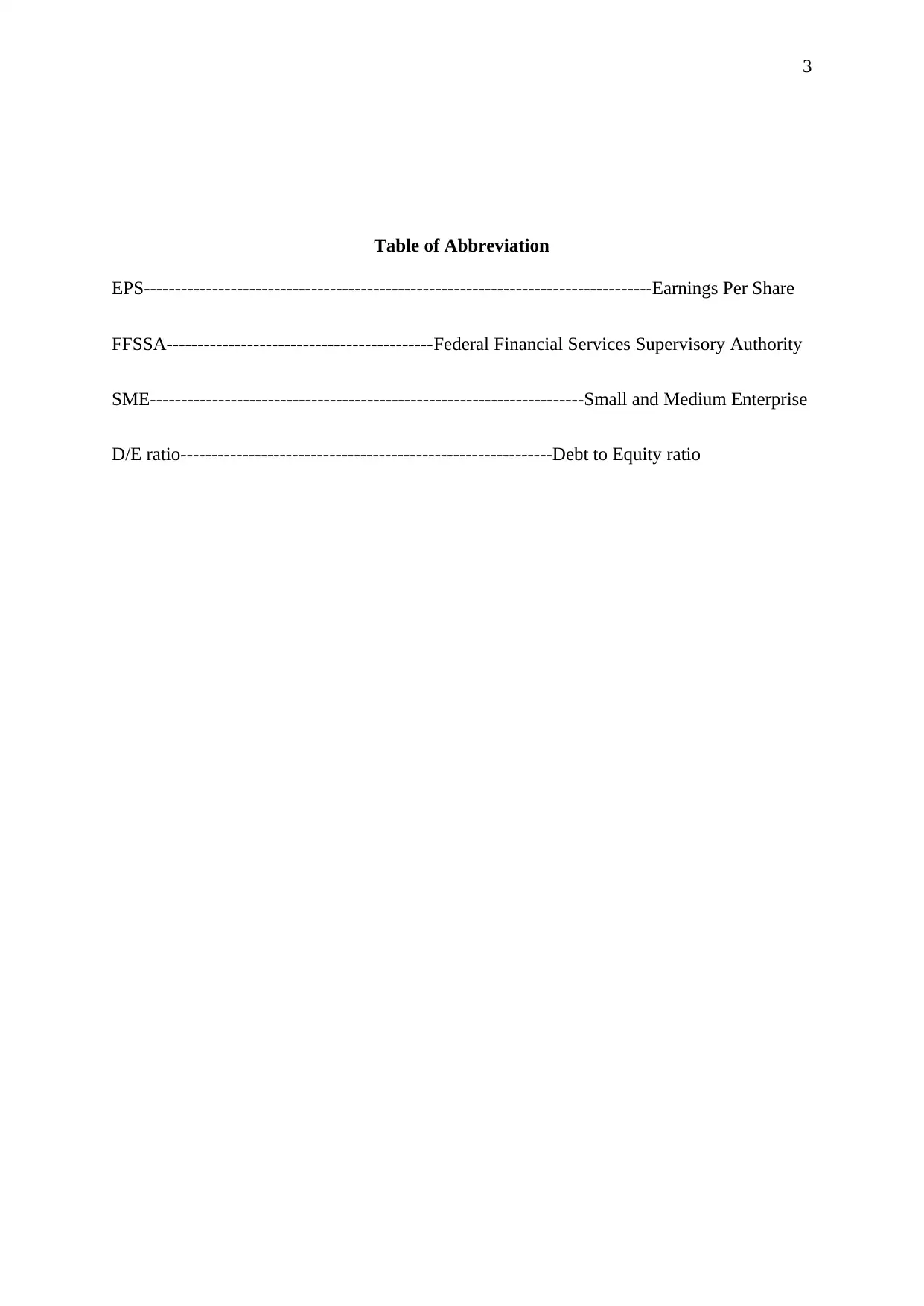
3
Table of Abbreviation
EPS----------------------------------------------------------------------------------Earnings Per Share
FFSSA-------------------------------------------Federal Financial Services Supervisory Authority
SME----------------------------------------------------------------------Small and Medium Enterprise
D/E ratio------------------------------------------------------------Debt to Equity ratio
Table of Abbreviation
EPS----------------------------------------------------------------------------------Earnings Per Share
FFSSA-------------------------------------------Federal Financial Services Supervisory Authority
SME----------------------------------------------------------------------Small and Medium Enterprise
D/E ratio------------------------------------------------------------Debt to Equity ratio
⊘ This is a preview!⊘
Do you want full access?
Subscribe today to unlock all pages.

Trusted by 1+ million students worldwide
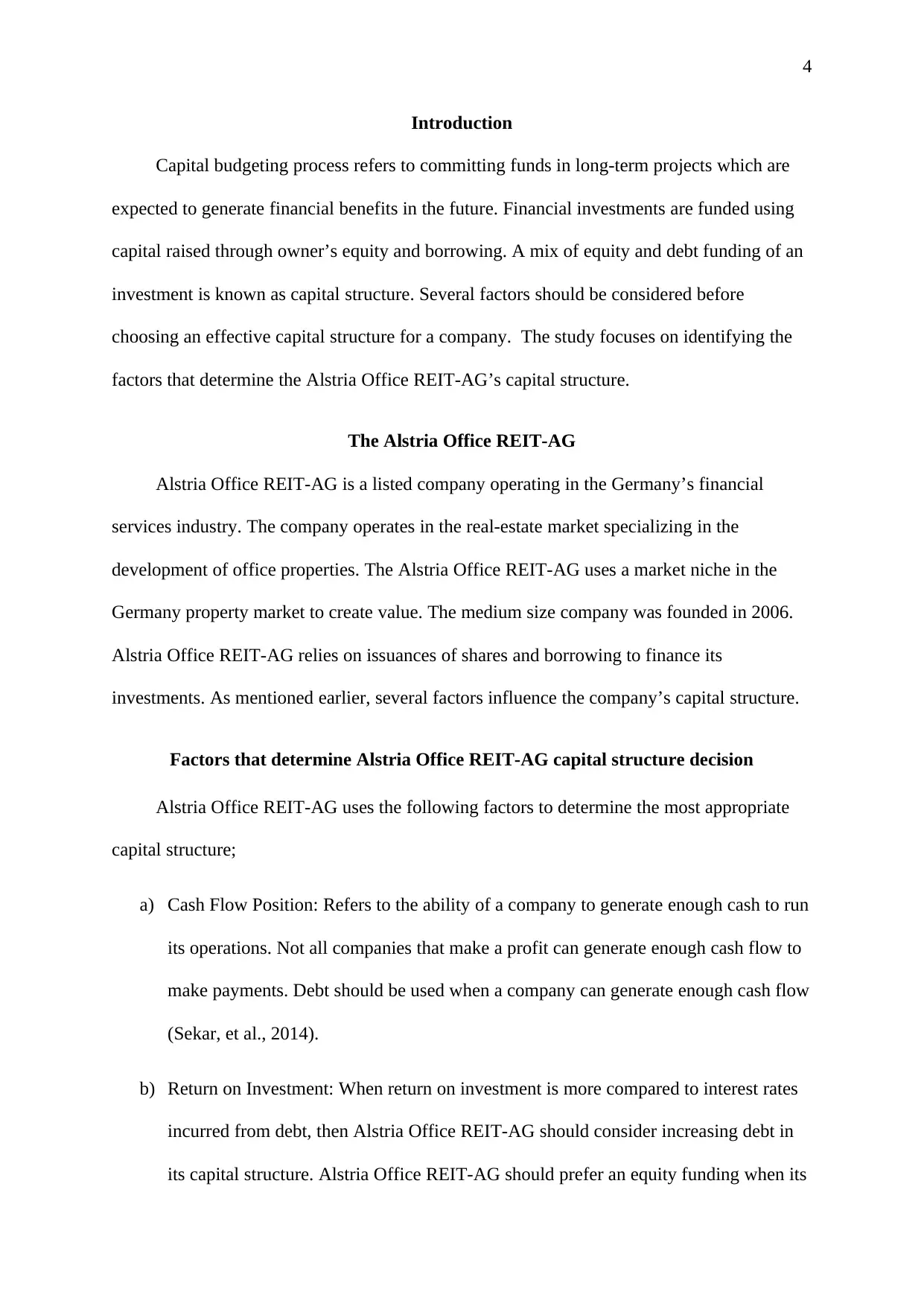
4
Introduction
Capital budgeting process refers to committing funds in long-term projects which are
expected to generate financial benefits in the future. Financial investments are funded using
capital raised through owner’s equity and borrowing. A mix of equity and debt funding of an
investment is known as capital structure. Several factors should be considered before
choosing an effective capital structure for a company. The study focuses on identifying the
factors that determine the Alstria Office REIT-AG’s capital structure.
The Alstria Office REIT-AG
Alstria Office REIT-AG is a listed company operating in the Germany’s financial
services industry. The company operates in the real-estate market specializing in the
development of office properties. The Alstria Office REIT-AG uses a market niche in the
Germany property market to create value. The medium size company was founded in 2006.
Alstria Office REIT-AG relies on issuances of shares and borrowing to finance its
investments. As mentioned earlier, several factors influence the company’s capital structure.
Factors that determine Alstria Office REIT-AG capital structure decision
Alstria Office REIT-AG uses the following factors to determine the most appropriate
capital structure;
a) Cash Flow Position: Refers to the ability of a company to generate enough cash to run
its operations. Not all companies that make a profit can generate enough cash flow to
make payments. Debt should be used when a company can generate enough cash flow
(Sekar, et al., 2014).
b) Return on Investment: When return on investment is more compared to interest rates
incurred from debt, then Alstria Office REIT-AG should consider increasing debt in
its capital structure. Alstria Office REIT-AG should prefer an equity funding when its
Introduction
Capital budgeting process refers to committing funds in long-term projects which are
expected to generate financial benefits in the future. Financial investments are funded using
capital raised through owner’s equity and borrowing. A mix of equity and debt funding of an
investment is known as capital structure. Several factors should be considered before
choosing an effective capital structure for a company. The study focuses on identifying the
factors that determine the Alstria Office REIT-AG’s capital structure.
The Alstria Office REIT-AG
Alstria Office REIT-AG is a listed company operating in the Germany’s financial
services industry. The company operates in the real-estate market specializing in the
development of office properties. The Alstria Office REIT-AG uses a market niche in the
Germany property market to create value. The medium size company was founded in 2006.
Alstria Office REIT-AG relies on issuances of shares and borrowing to finance its
investments. As mentioned earlier, several factors influence the company’s capital structure.
Factors that determine Alstria Office REIT-AG capital structure decision
Alstria Office REIT-AG uses the following factors to determine the most appropriate
capital structure;
a) Cash Flow Position: Refers to the ability of a company to generate enough cash to run
its operations. Not all companies that make a profit can generate enough cash flow to
make payments. Debt should be used when a company can generate enough cash flow
(Sekar, et al., 2014).
b) Return on Investment: When return on investment is more compared to interest rates
incurred from debt, then Alstria Office REIT-AG should consider increasing debt in
its capital structure. Alstria Office REIT-AG should prefer an equity funding when its
Paraphrase This Document
Need a fresh take? Get an instant paraphrase of this document with our AI Paraphraser
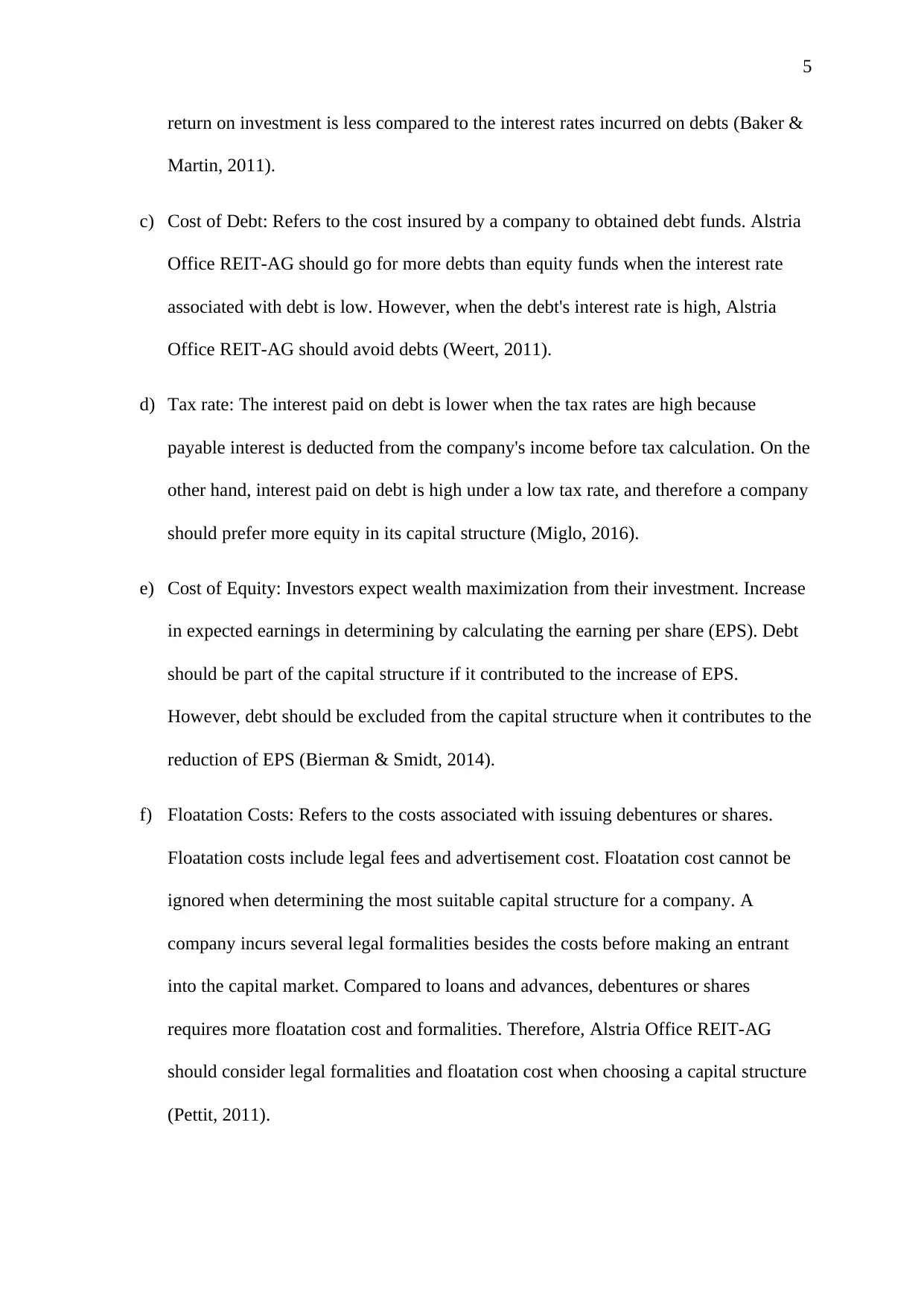
5
return on investment is less compared to the interest rates incurred on debts (Baker &
Martin, 2011).
c) Cost of Debt: Refers to the cost insured by a company to obtained debt funds. Alstria
Office REIT-AG should go for more debts than equity funds when the interest rate
associated with debt is low. However, when the debt's interest rate is high, Alstria
Office REIT-AG should avoid debts (Weert, 2011).
d) Tax rate: The interest paid on debt is lower when the tax rates are high because
payable interest is deducted from the company's income before tax calculation. On the
other hand, interest paid on debt is high under a low tax rate, and therefore a company
should prefer more equity in its capital structure (Miglo, 2016).
e) Cost of Equity: Investors expect wealth maximization from their investment. Increase
in expected earnings in determining by calculating the earning per share (EPS). Debt
should be part of the capital structure if it contributed to the increase of EPS.
However, debt should be excluded from the capital structure when it contributes to the
reduction of EPS (Bierman & Smidt, 2014).
f) Floatation Costs: Refers to the costs associated with issuing debentures or shares.
Floatation costs include legal fees and advertisement cost. Floatation cost cannot be
ignored when determining the most suitable capital structure for a company. A
company incurs several legal formalities besides the costs before making an entrant
into the capital market. Compared to loans and advances, debentures or shares
requires more floatation cost and formalities. Therefore, Alstria Office REIT-AG
should consider legal formalities and floatation cost when choosing a capital structure
(Pettit, 2011).
return on investment is less compared to the interest rates incurred on debts (Baker &
Martin, 2011).
c) Cost of Debt: Refers to the cost insured by a company to obtained debt funds. Alstria
Office REIT-AG should go for more debts than equity funds when the interest rate
associated with debt is low. However, when the debt's interest rate is high, Alstria
Office REIT-AG should avoid debts (Weert, 2011).
d) Tax rate: The interest paid on debt is lower when the tax rates are high because
payable interest is deducted from the company's income before tax calculation. On the
other hand, interest paid on debt is high under a low tax rate, and therefore a company
should prefer more equity in its capital structure (Miglo, 2016).
e) Cost of Equity: Investors expect wealth maximization from their investment. Increase
in expected earnings in determining by calculating the earning per share (EPS). Debt
should be part of the capital structure if it contributed to the increase of EPS.
However, debt should be excluded from the capital structure when it contributes to the
reduction of EPS (Bierman & Smidt, 2014).
f) Floatation Costs: Refers to the costs associated with issuing debentures or shares.
Floatation costs include legal fees and advertisement cost. Floatation cost cannot be
ignored when determining the most suitable capital structure for a company. A
company incurs several legal formalities besides the costs before making an entrant
into the capital market. Compared to loans and advances, debentures or shares
requires more floatation cost and formalities. Therefore, Alstria Office REIT-AG
should consider legal formalities and floatation cost when choosing a capital structure
(Pettit, 2011).
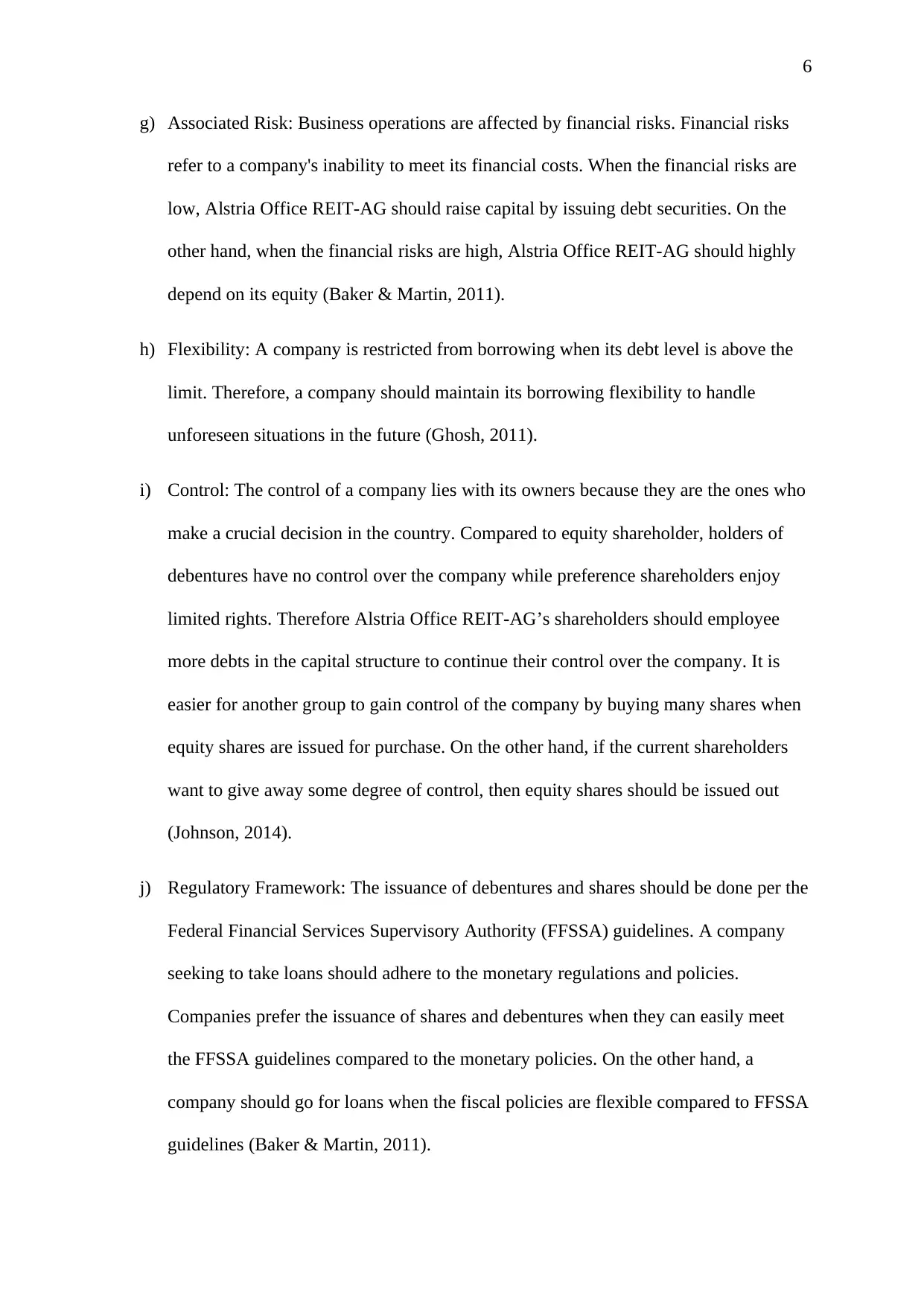
6
g) Associated Risk: Business operations are affected by financial risks. Financial risks
refer to a company's inability to meet its financial costs. When the financial risks are
low, Alstria Office REIT-AG should raise capital by issuing debt securities. On the
other hand, when the financial risks are high, Alstria Office REIT-AG should highly
depend on its equity (Baker & Martin, 2011).
h) Flexibility: A company is restricted from borrowing when its debt level is above the
limit. Therefore, a company should maintain its borrowing flexibility to handle
unforeseen situations in the future (Ghosh, 2011).
i) Control: The control of a company lies with its owners because they are the ones who
make a crucial decision in the country. Compared to equity shareholder, holders of
debentures have no control over the company while preference shareholders enjoy
limited rights. Therefore Alstria Office REIT-AG’s shareholders should employee
more debts in the capital structure to continue their control over the company. It is
easier for another group to gain control of the company by buying many shares when
equity shares are issued for purchase. On the other hand, if the current shareholders
want to give away some degree of control, then equity shares should be issued out
(Johnson, 2014).
j) Regulatory Framework: The issuance of debentures and shares should be done per the
Federal Financial Services Supervisory Authority (FFSSA) guidelines. A company
seeking to take loans should adhere to the monetary regulations and policies.
Companies prefer the issuance of shares and debentures when they can easily meet
the FFSSA guidelines compared to the monetary policies. On the other hand, a
company should go for loans when the fiscal policies are flexible compared to FFSSA
guidelines (Baker & Martin, 2011).
g) Associated Risk: Business operations are affected by financial risks. Financial risks
refer to a company's inability to meet its financial costs. When the financial risks are
low, Alstria Office REIT-AG should raise capital by issuing debt securities. On the
other hand, when the financial risks are high, Alstria Office REIT-AG should highly
depend on its equity (Baker & Martin, 2011).
h) Flexibility: A company is restricted from borrowing when its debt level is above the
limit. Therefore, a company should maintain its borrowing flexibility to handle
unforeseen situations in the future (Ghosh, 2011).
i) Control: The control of a company lies with its owners because they are the ones who
make a crucial decision in the country. Compared to equity shareholder, holders of
debentures have no control over the company while preference shareholders enjoy
limited rights. Therefore Alstria Office REIT-AG’s shareholders should employee
more debts in the capital structure to continue their control over the company. It is
easier for another group to gain control of the company by buying many shares when
equity shares are issued for purchase. On the other hand, if the current shareholders
want to give away some degree of control, then equity shares should be issued out
(Johnson, 2014).
j) Regulatory Framework: The issuance of debentures and shares should be done per the
Federal Financial Services Supervisory Authority (FFSSA) guidelines. A company
seeking to take loans should adhere to the monetary regulations and policies.
Companies prefer the issuance of shares and debentures when they can easily meet
the FFSSA guidelines compared to the monetary policies. On the other hand, a
company should go for loans when the fiscal policies are flexible compared to FFSSA
guidelines (Baker & Martin, 2011).
⊘ This is a preview!⊘
Do you want full access?
Subscribe today to unlock all pages.

Trusted by 1+ million students worldwide
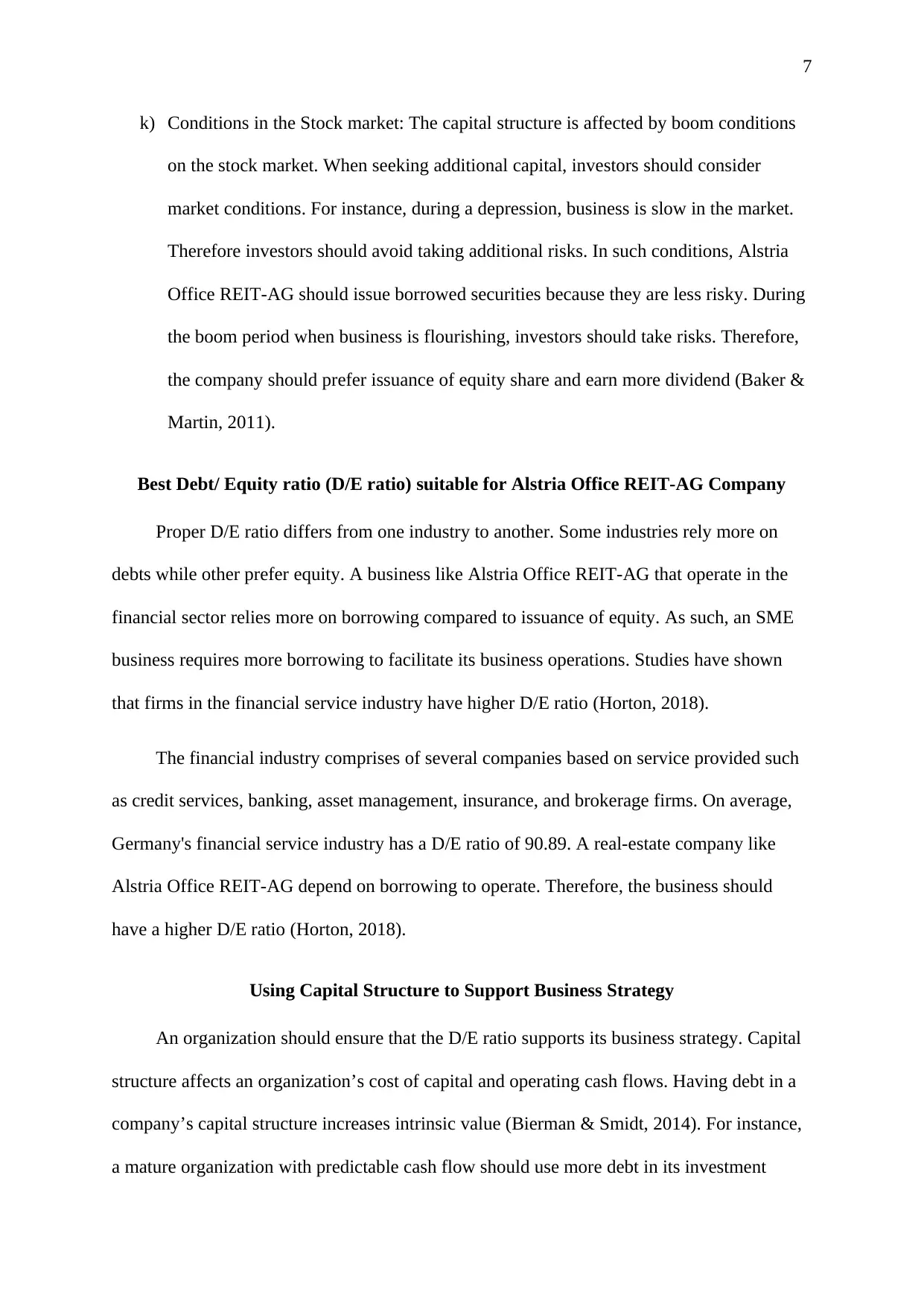
7
k) Conditions in the Stock market: The capital structure is affected by boom conditions
on the stock market. When seeking additional capital, investors should consider
market conditions. For instance, during a depression, business is slow in the market.
Therefore investors should avoid taking additional risks. In such conditions, Alstria
Office REIT-AG should issue borrowed securities because they are less risky. During
the boom period when business is flourishing, investors should take risks. Therefore,
the company should prefer issuance of equity share and earn more dividend (Baker &
Martin, 2011).
Best Debt/ Equity ratio (D/E ratio) suitable for Alstria Office REIT-AG Company
Proper D/E ratio differs from one industry to another. Some industries rely more on
debts while other prefer equity. A business like Alstria Office REIT-AG that operate in the
financial sector relies more on borrowing compared to issuance of equity. As such, an SME
business requires more borrowing to facilitate its business operations. Studies have shown
that firms in the financial service industry have higher D/E ratio (Horton, 2018).
The financial industry comprises of several companies based on service provided such
as credit services, banking, asset management, insurance, and brokerage firms. On average,
Germany's financial service industry has a D/E ratio of 90.89. A real-estate company like
Alstria Office REIT-AG depend on borrowing to operate. Therefore, the business should
have a higher D/E ratio (Horton, 2018).
Using Capital Structure to Support Business Strategy
An organization should ensure that the D/E ratio supports its business strategy. Capital
structure affects an organization’s cost of capital and operating cash flows. Having debt in a
company’s capital structure increases intrinsic value (Bierman & Smidt, 2014). For instance,
a mature organization with predictable cash flow should use more debt in its investment
k) Conditions in the Stock market: The capital structure is affected by boom conditions
on the stock market. When seeking additional capital, investors should consider
market conditions. For instance, during a depression, business is slow in the market.
Therefore investors should avoid taking additional risks. In such conditions, Alstria
Office REIT-AG should issue borrowed securities because they are less risky. During
the boom period when business is flourishing, investors should take risks. Therefore,
the company should prefer issuance of equity share and earn more dividend (Baker &
Martin, 2011).
Best Debt/ Equity ratio (D/E ratio) suitable for Alstria Office REIT-AG Company
Proper D/E ratio differs from one industry to another. Some industries rely more on
debts while other prefer equity. A business like Alstria Office REIT-AG that operate in the
financial sector relies more on borrowing compared to issuance of equity. As such, an SME
business requires more borrowing to facilitate its business operations. Studies have shown
that firms in the financial service industry have higher D/E ratio (Horton, 2018).
The financial industry comprises of several companies based on service provided such
as credit services, banking, asset management, insurance, and brokerage firms. On average,
Germany's financial service industry has a D/E ratio of 90.89. A real-estate company like
Alstria Office REIT-AG depend on borrowing to operate. Therefore, the business should
have a higher D/E ratio (Horton, 2018).
Using Capital Structure to Support Business Strategy
An organization should ensure that the D/E ratio supports its business strategy. Capital
structure affects an organization’s cost of capital and operating cash flows. Having debt in a
company’s capital structure increases intrinsic value (Bierman & Smidt, 2014). For instance,
a mature organization with predictable cash flow should use more debt in its investment
Paraphrase This Document
Need a fresh take? Get an instant paraphrase of this document with our AI Paraphraser
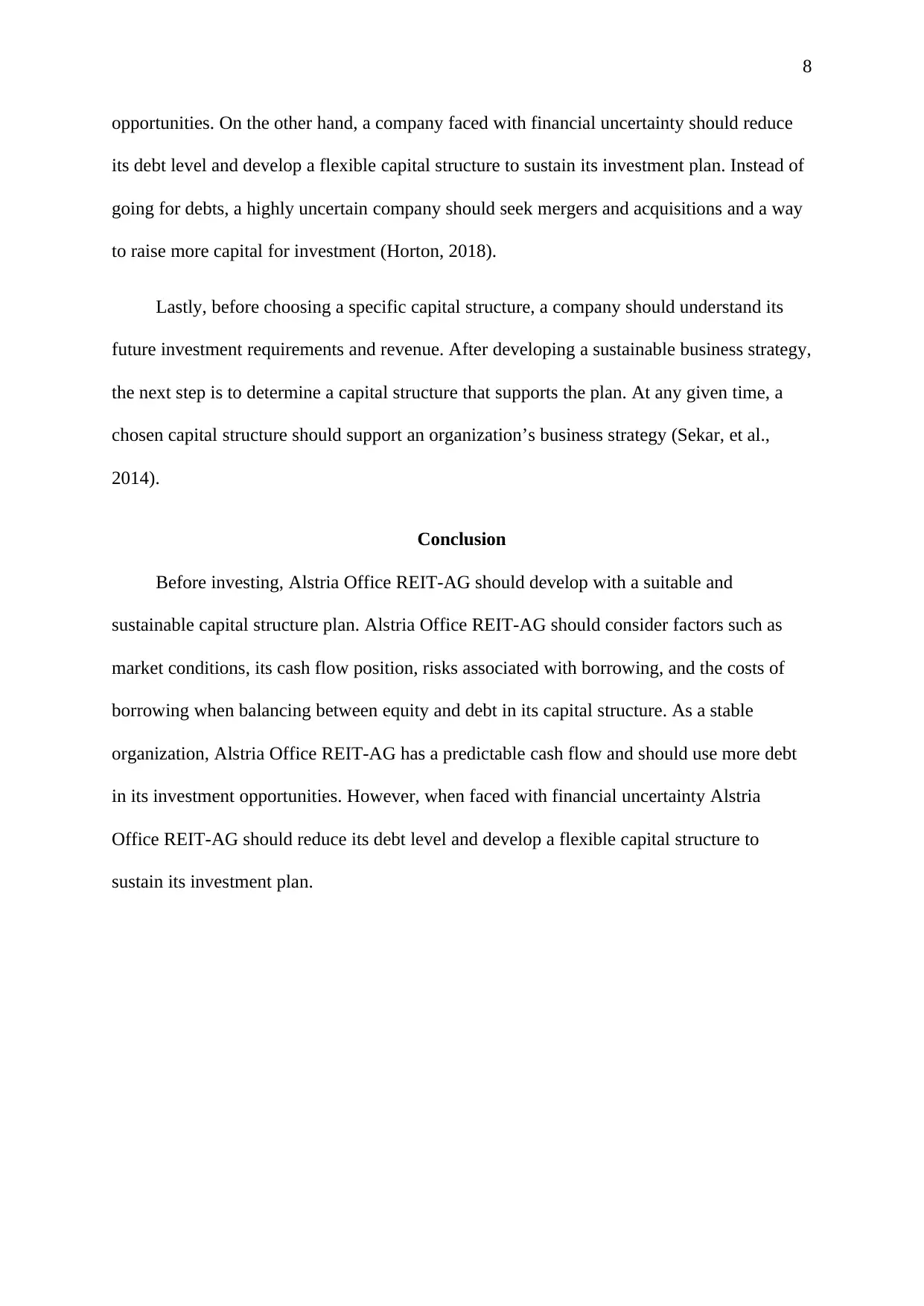
8
opportunities. On the other hand, a company faced with financial uncertainty should reduce
its debt level and develop a flexible capital structure to sustain its investment plan. Instead of
going for debts, a highly uncertain company should seek mergers and acquisitions and a way
to raise more capital for investment (Horton, 2018).
Lastly, before choosing a specific capital structure, a company should understand its
future investment requirements and revenue. After developing a sustainable business strategy,
the next step is to determine a capital structure that supports the plan. At any given time, a
chosen capital structure should support an organization’s business strategy (Sekar, et al.,
2014).
Conclusion
Before investing, Alstria Office REIT-AG should develop with a suitable and
sustainable capital structure plan. Alstria Office REIT-AG should consider factors such as
market conditions, its cash flow position, risks associated with borrowing, and the costs of
borrowing when balancing between equity and debt in its capital structure. As a stable
organization, Alstria Office REIT-AG has a predictable cash flow and should use more debt
in its investment opportunities. However, when faced with financial uncertainty Alstria
Office REIT-AG should reduce its debt level and develop a flexible capital structure to
sustain its investment plan.
opportunities. On the other hand, a company faced with financial uncertainty should reduce
its debt level and develop a flexible capital structure to sustain its investment plan. Instead of
going for debts, a highly uncertain company should seek mergers and acquisitions and a way
to raise more capital for investment (Horton, 2018).
Lastly, before choosing a specific capital structure, a company should understand its
future investment requirements and revenue. After developing a sustainable business strategy,
the next step is to determine a capital structure that supports the plan. At any given time, a
chosen capital structure should support an organization’s business strategy (Sekar, et al.,
2014).
Conclusion
Before investing, Alstria Office REIT-AG should develop with a suitable and
sustainable capital structure plan. Alstria Office REIT-AG should consider factors such as
market conditions, its cash flow position, risks associated with borrowing, and the costs of
borrowing when balancing between equity and debt in its capital structure. As a stable
organization, Alstria Office REIT-AG has a predictable cash flow and should use more debt
in its investment opportunities. However, when faced with financial uncertainty Alstria
Office REIT-AG should reduce its debt level and develop a flexible capital structure to
sustain its investment plan.
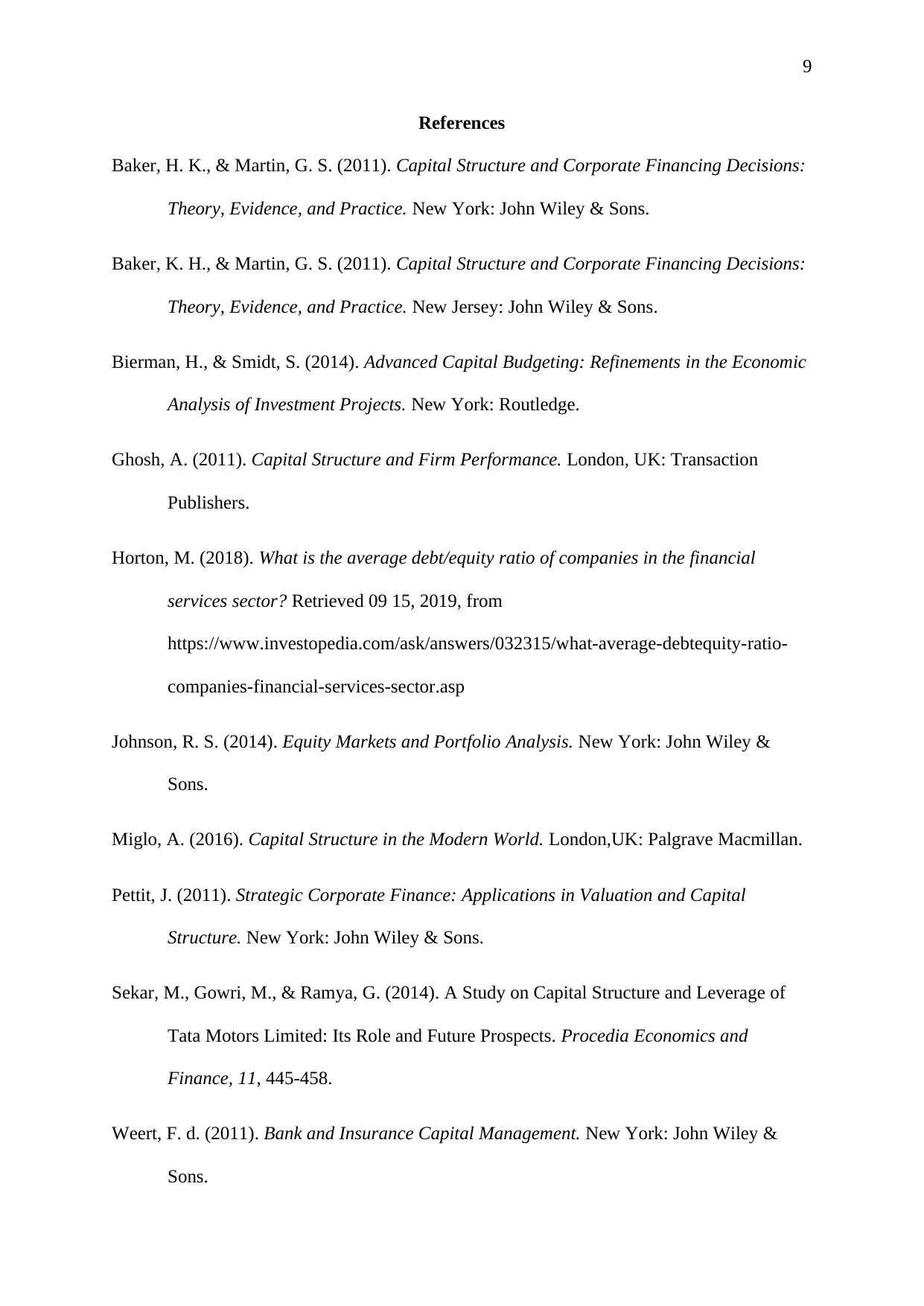
9
References
Baker, H. K., & Martin, G. S. (2011). Capital Structure and Corporate Financing Decisions:
Theory, Evidence, and Practice. New York: John Wiley & Sons.
Baker, K. H., & Martin, G. S. (2011). Capital Structure and Corporate Financing Decisions:
Theory, Evidence, and Practice. New Jersey: John Wiley & Sons.
Bierman, H., & Smidt, S. (2014). Advanced Capital Budgeting: Refinements in the Economic
Analysis of Investment Projects. New York: Routledge.
Ghosh, A. (2011). Capital Structure and Firm Performance. London, UK: Transaction
Publishers.
Horton, M. (2018). What is the average debt/equity ratio of companies in the financial
services sector? Retrieved 09 15, 2019, from
https://www.investopedia.com/ask/answers/032315/what-average-debtequity-ratio-
companies-financial-services-sector.asp
Johnson, R. S. (2014). Equity Markets and Portfolio Analysis. New York: John Wiley &
Sons.
Miglo, A. (2016). Capital Structure in the Modern World. London,UK: Palgrave Macmillan.
Pettit, J. (2011). Strategic Corporate Finance: Applications in Valuation and Capital
Structure. New York: John Wiley & Sons.
Sekar, M., Gowri, M., & Ramya, G. (2014). A Study on Capital Structure and Leverage of
Tata Motors Limited: Its Role and Future Prospects. Procedia Economics and
Finance, 11, 445-458.
Weert, F. d. (2011). Bank and Insurance Capital Management. New York: John Wiley &
Sons.
References
Baker, H. K., & Martin, G. S. (2011). Capital Structure and Corporate Financing Decisions:
Theory, Evidence, and Practice. New York: John Wiley & Sons.
Baker, K. H., & Martin, G. S. (2011). Capital Structure and Corporate Financing Decisions:
Theory, Evidence, and Practice. New Jersey: John Wiley & Sons.
Bierman, H., & Smidt, S. (2014). Advanced Capital Budgeting: Refinements in the Economic
Analysis of Investment Projects. New York: Routledge.
Ghosh, A. (2011). Capital Structure and Firm Performance. London, UK: Transaction
Publishers.
Horton, M. (2018). What is the average debt/equity ratio of companies in the financial
services sector? Retrieved 09 15, 2019, from
https://www.investopedia.com/ask/answers/032315/what-average-debtequity-ratio-
companies-financial-services-sector.asp
Johnson, R. S. (2014). Equity Markets and Portfolio Analysis. New York: John Wiley &
Sons.
Miglo, A. (2016). Capital Structure in the Modern World. London,UK: Palgrave Macmillan.
Pettit, J. (2011). Strategic Corporate Finance: Applications in Valuation and Capital
Structure. New York: John Wiley & Sons.
Sekar, M., Gowri, M., & Ramya, G. (2014). A Study on Capital Structure and Leverage of
Tata Motors Limited: Its Role and Future Prospects. Procedia Economics and
Finance, 11, 445-458.
Weert, F. d. (2011). Bank and Insurance Capital Management. New York: John Wiley &
Sons.
⊘ This is a preview!⊘
Do you want full access?
Subscribe today to unlock all pages.

Trusted by 1+ million students worldwide
1 out of 9
Related Documents
Your All-in-One AI-Powered Toolkit for Academic Success.
+13062052269
info@desklib.com
Available 24*7 on WhatsApp / Email
![[object Object]](/_next/static/media/star-bottom.7253800d.svg)
Unlock your academic potential
Copyright © 2020–2025 A2Z Services. All Rights Reserved. Developed and managed by ZUCOL.




